|
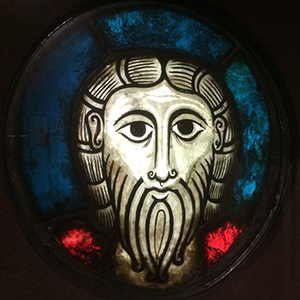 |
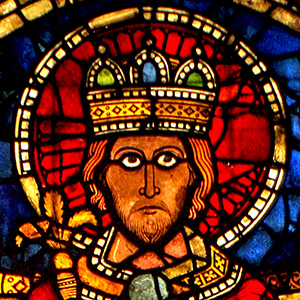 |
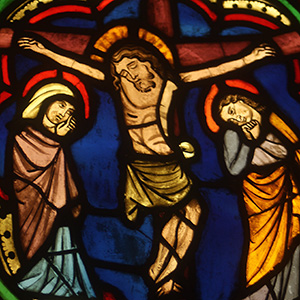 |
|
The Wissembourg Head is one of the oldest pieces of artistic church window glass that has survived in a piece (fragments of 10th and early 11th century glass exist), and perhaps the oldest stained glass depicting Jesus (although it may not depict Jesus). The blue and red colors around the face were added centuries later. It was made sometime between 1050 and 1090, with some sources simply stating it was made around 1070. It was in the Abbey Church of Wissembourg, Alsace. Wissembourg is right on what is now the border with Germany, about thirty kilometers west of the northeast tip of France, north of Haguenau.
彩色玻璃窗 |
This stained glass emperor enthroned in majesty was put up in the Strasbourg Cathederal during construction in the last quarter of the 12th century (sometime between 1175 and 1200). In 1880 it was placed in the museum. It seems to have escaped the damage done to much of the cathederal's stained glass by invading German armies in 1871. In the late 12th century, England was ruled by Henry the Second and Richard the First (Lionheart). Of course, Strasbourg was at the time part of the Holy Roman Empire; it was a micro-state ruled by its bishop within the Empire. Click on the image to see a large full body length image of the emperor. 彩色玻璃窗 |
This image of the crucifixion of Jesus was made in 1260, and decorated the old church of the Dominicans in Strasbourg for many centuries. It was created about 200 years after the first image on this row, and a little less than a century after the image to the left. Look at the woman on the left, perhaps Mary Magdalene (or perhaps Mary of Nazareth, the mother of Jesus, or even Salome, the mother of James and John?). The artists have been successful in using simple lines to indicate the mixed feelings of grief and sorrow combined with love, devotion, and awe. 彩色玻璃窗 |
|
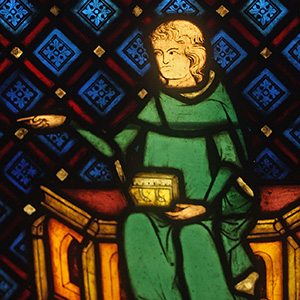 |
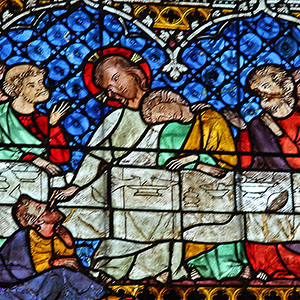 |
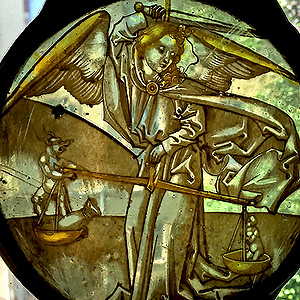 |
|
A young cleric. This window was created in the 1320s. It was in the Strasbourg cathedral, but now it is in the cathedral museum. The Strasbourg cathedral was completed in its present form in the mid 15th century, but parts of it were finished in the 13th and 14th century, and the 13th century portions are generally considered to be artistically superior. I am curious about what is in the box the cleric holds in his lap. It could hold a bible, or relics, I suppose, but it looks a little bit like a modern lunch box. This window is in the museum now, and removed from its context, I can't know toward what the cleric was gesturing. |
A window depicting the last supper. Jesus is offering a bit of food to one of the disciples in a gesture that resembles the action of a cleric providing the Eurcharist. I guess this is a late 13th century window, but I'm no expert, and it could 14th century. In the earlier depictions of the Last Supper, such as this window, the table is usually set with a meal of fish and bread, but in later works, artists show lamb on the table. I associate the concave faces here, where the chin and beard stick out as do the foreheads and hair, leaving the eyes and noses set back, with a 13th century style of portraying faces. |
Here is a small piece of glass from 1490 showing Saint Michael, as an angel, weighing the souls of the dead. There is a horned humanoid pig demon trying to weigh down the sins so that this particular soul will be condemned to hell, but it appears as if the soul is, despite the demon's efforts, going to be measured as worthy of salvation. In this visual metaphor, the soul being weighed is set against its sins, which are separated from it. This reflects a view that our "real" nature is to be good, and the "sins" and things that drag us spiritually down are external to us, or at least they are separted from the true self upon our death. |
|
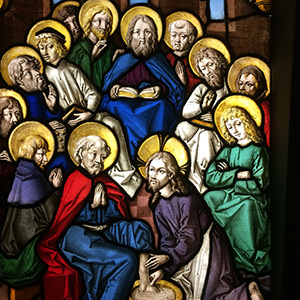 |
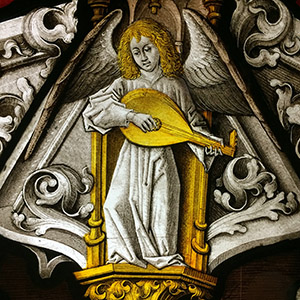 |
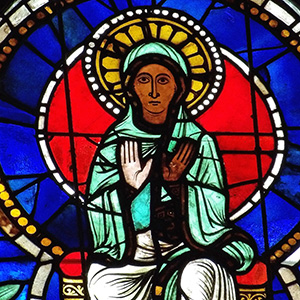 |
|
Christ washing the feet of his disciples, made sometime between 1478-1481 by Peter Hemmel of Andlau and his workshop. This demonstration of humility and call for us to follow His example and serve others in our lives, is not always given much attention in artistic depictions, especially compared to the image of Christ as Ruler of the Cosmos. |
This is an angel playing a lute above the scene of Jesus washing his disciples' feet, in the work by Peter Hemmel from the 1470s or 1480s. Angels are often portrayed playing musical intruments, showing a conventional association in the popular imagination that music, which is so irrational compared to language, has spiritual power |
I am not sure why in this portrayal of Mary her right hand is so white. Was this an intentional decision of the artists, or was there something about the coloring of the glass that, perhaps over the centuries, has let the color fade? Anyway, Mary looks serene in this depiction, and she seems older, perhaps this shows her late in her life. |
|
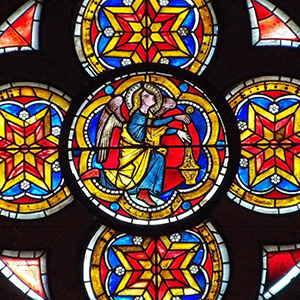 |
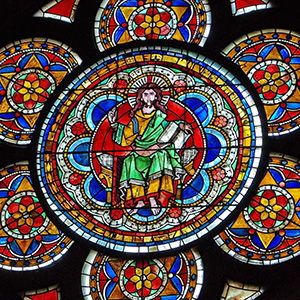 |
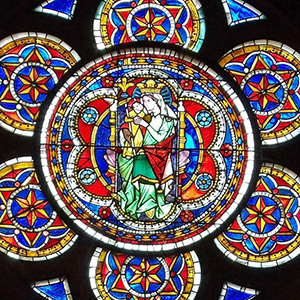 |
|
Stained glass in the Strasbourg cathedral; an angel kneels in a devotional pose. |
Stained glass in the Strasbourg cathedral; Christ as the ruler of the universe. |
Stained glass in the Strasbourg cathedral; Christ as a child adored on His mother's lap by Mary, who sits enthroned and crowned. |
|
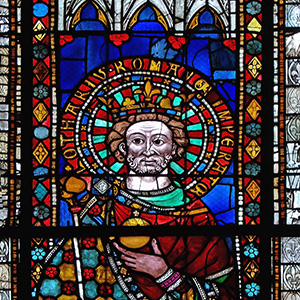 |
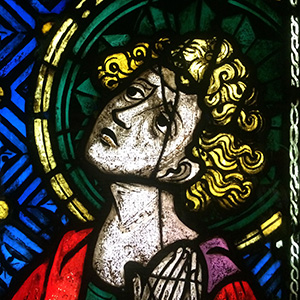 |
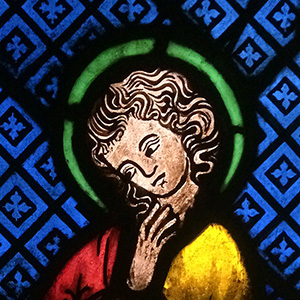 |
|
Lothar (Lotharius), the Holy Roman Emperor. This is Lothar the First, who finally abdicated late in his life to become a monk, but his career as emperor would not, I think, justify his placement in a church window. In fact, the famous "Oath of Strasbourg" (842, which some authorities describe as the first time the French language appears in a written document) was a sort of treaty among his brothers (grandsons of Charles the First) establishing an alliance against Lothar. The Strasbourg Cathedral has some windows featuring various early Holy Roman Emperors. |
This scene in stained glass, which I think must date to the 15th century, portrays a saint or disciple in prayer, with his eyes lifted toward the heavens. |
Stained glass from the 13th (or perhaps 14th?) century. Rather than looking toward the heavens, this saint looks down, and holds a hand under his face. |
|
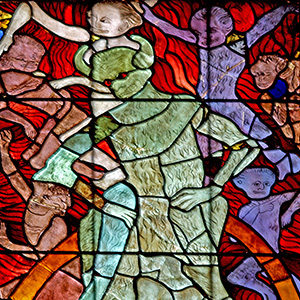 |
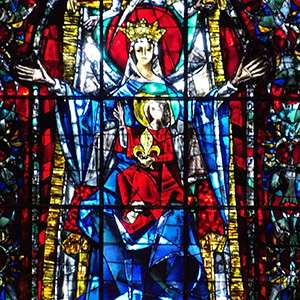 |
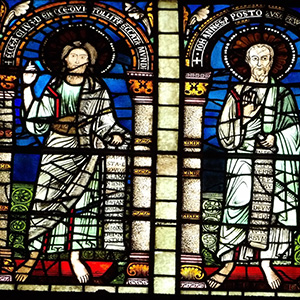 |
|
Horrible scenes of hell. This demonic figure has a cartoonish face, and the glowing red eyes look to me as if he is wearing red-tinted spectacles. |
On the eastern end of the nave, high above the central altar, Mary spreads her arms to offer blessings to all the visitors in her cathedral (the Strasbourg Cathedral is dedicated to Mary). |
Jesus stands as the Agnus Dei and yet in this portrayal I see no lamb. |
|
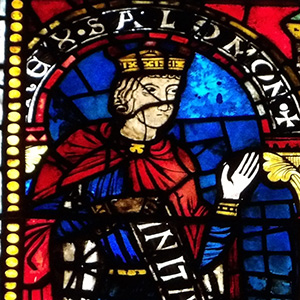 |
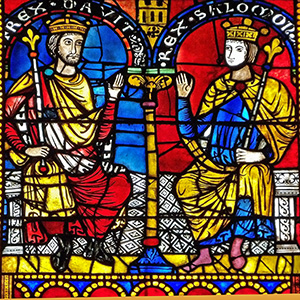 |
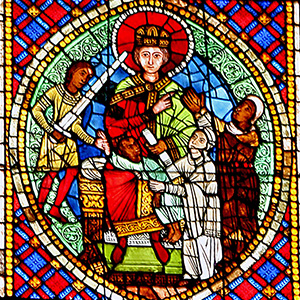 |
|
Here is one of the several depictions of King Soloman in the Strasbourg Cathedral. |
We see King Solomon seating on the right, wearing his blue shirt and yellow robe. That is King David on the left, later in his career, when he was king, long after his earlier adventures as a musician and giant-slayer. |
This glass window shows the story of how Solomon refused to allow schism or disunity in the community of God (Solomon insisted on a unified Israel and Judea, which is portrayed in the figurative story of the two women who came to him disputing over who was the rightful mother of a child). |
|
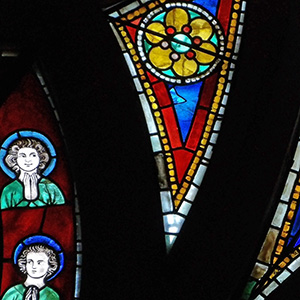 |
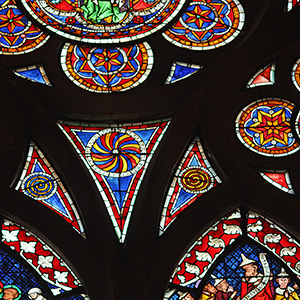 |
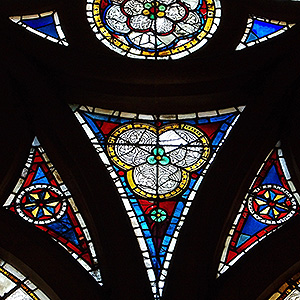 |
|
In this set of windows, notice how happy the person who is praying seems to be, with an expression of joy on their face. It almost looks as if they are about to laugh. |
The artists who designed the windows in the Strasbourg cathedral had a wild sense of color and design. |
Stained glass in the Strasbourg Cathedral. |
|
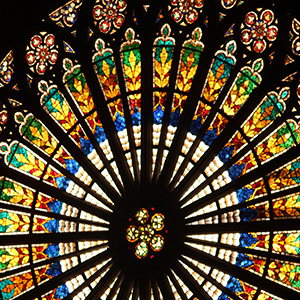 |
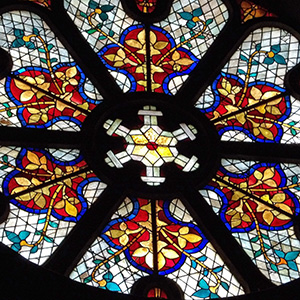 |
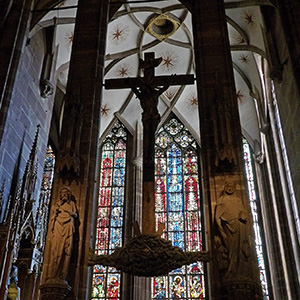 |
|
The Strasbourg Cathedral great rose window you can see above was destroyed by the German army when they attacked Strasbourg in 1871, and so this particular window was restored (recreated) in the late 19th century. |
A lovely example of colored glass windows in the Strasbourg Cathedral |
Inside the Strasbourg cathedral, one of several statues depicting the passion of Christ. |
|
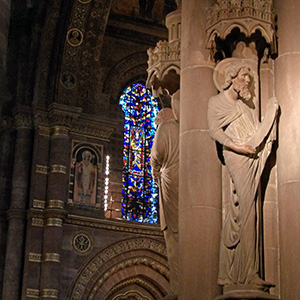 |
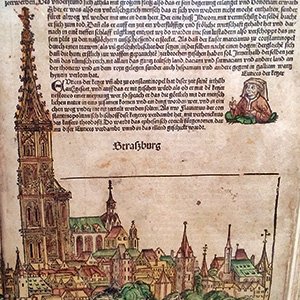 |
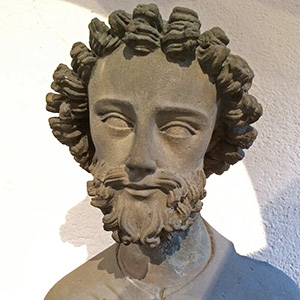 |
|
A view of a statue and a stained glass window inside of Strasbourg Cathedral |
Strasbourg Cathedral was described in this guide to the area, published in 1490. You can see the spire of the church is illustrated here; the spire was completed in 1439, and at 144 meters above the ground, it was for many years the tallest church spire in the world. |
One of many statues from High Middle Ages of the 13th, 14th, and 15th century now displayed in the cathedral museum. Of all the statues, this man's facial expression seemed the most interesting to me. Something about the eyes and mouth suggest big-heartedness to me. |
|
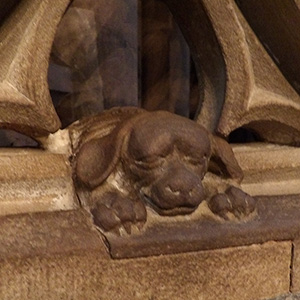 |
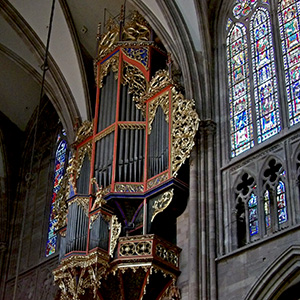 |
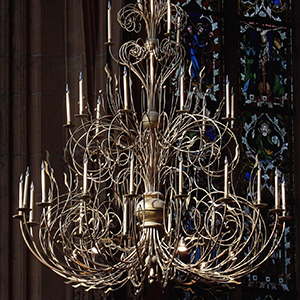 |
|
Strasbourg Cathedral. This is a very small stone dog that was carved into the stone pulpit. There is a story that one of the clerics used to give long sermons, and his little loyal dog who follwed him could not stay awake through all the long sermons. |
Strasbourg Cathedral's organ. |
Strasbourg Cathedral has some impressive Chandeliers |
|
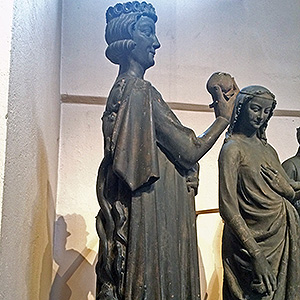 |
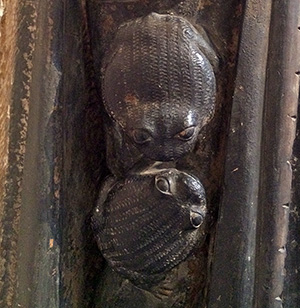 |
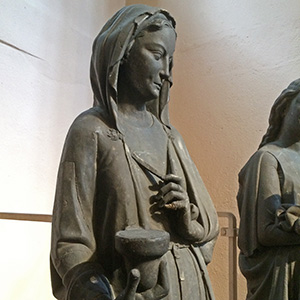 |
|
Here is temptation (or evil, or the devil), personified as a figure who seems attractive from the front, and holds an apple, but a closer look behind the statue shows that beneath the figure's clothing, toads and snakes inhabit the hidden back of temptation. On the western facade of the cathedral tempation is grouped with some foolish girls who have not preserved their wine in their cups, and this group stands across from the wise girls, who hold their cups upright and stand away from Temptation.
|
When the statue of temptation was put up as part of the western facade of the cathedral (in the mid-to-late 1200s), it would have been difficult to see clearly the toads and snakes, but now that the original is displayed in the museum, anyone can get a good look at them. |
Strasbourg Cathedral had many statues dating from the 13th to 15th centuries that were suffering from exposure to weather and pollution, and so in the early years of the 20th century, many of the original stone statues were removed from the cathedral and placed in the museum, and replacements now stand on the cathedral. The original statues, such as the figure above, showing one of the virtuous girls, are collected in the cathedral museum or in other great museums of the world. |
|
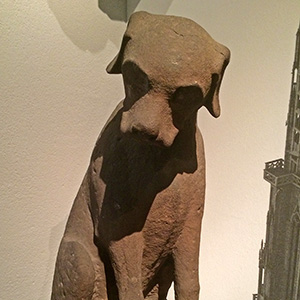 |
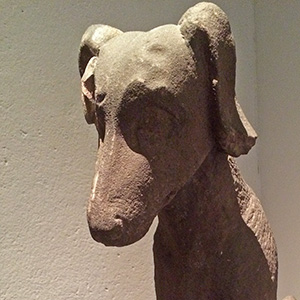 |
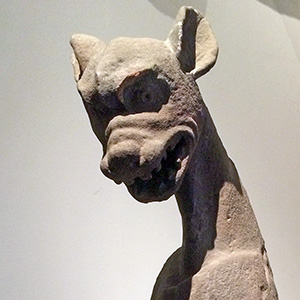 |
|
Strasbourg Cathedral has had many 13th and 14th century dog statues on it, including this one. |
This statue was on the Strasbourg cathedral from around 1260 until around 1900, when it was replaced by a new dog statue, and took its place in the museum. |
A chimera from the Strasbourg cathedral, now in the cathedral museum. |
|
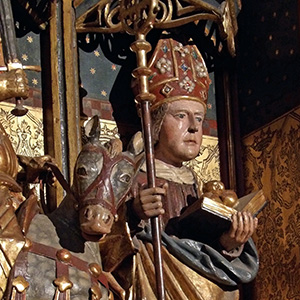 |
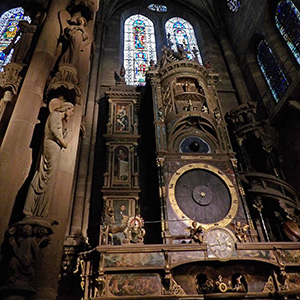 |
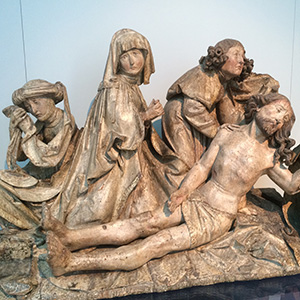 |
|
A typical 16th century carving in the cathedral. |
Strasbourg Cathedral has a famous astronomical clock, shown above. |
The descent of Christ from the Cross, before His family washed his body and took it away to the tomb. This was carved in 1501. |
|
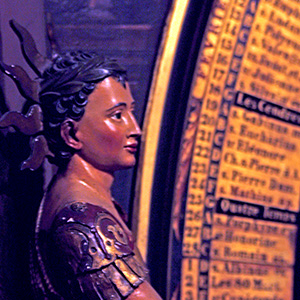 |
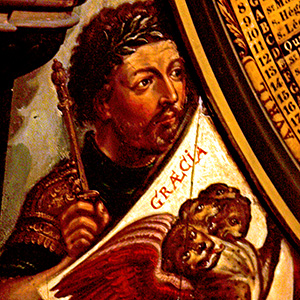 |
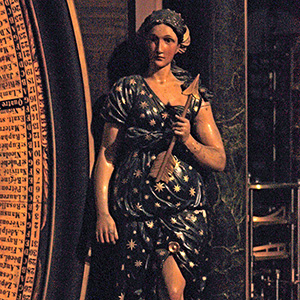 |
|
A figure by the Strasbourg Cathedral astronomical clock |
A painting on the astronomical clock |
I like the design on this female statue's dress. |
|
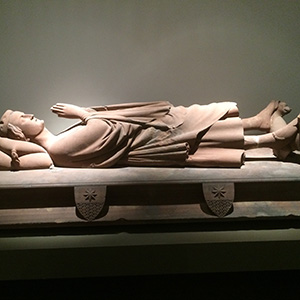 |
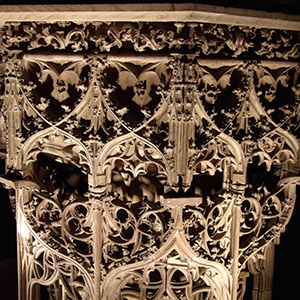 |
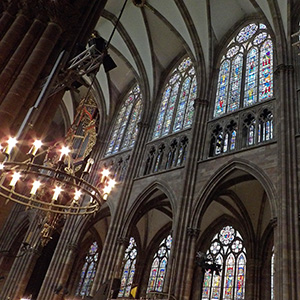 |
|
Funeral monument in Strasbourg Cathedral Museum |
Strasbourg Cathedral. |
The interior of the Strasbourg Cathedral, looking up toward some of the glorious stained glass windows. |
|
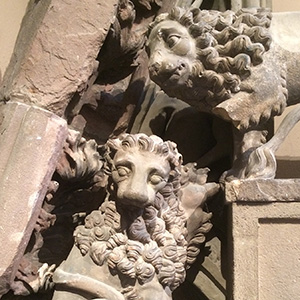 |
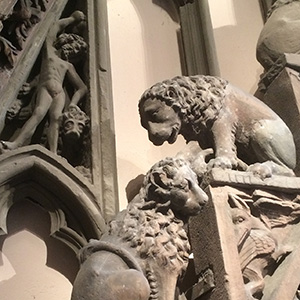 |
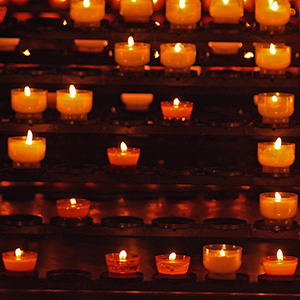 |
|
Lions from the 13th century western facade of the cathedral, now safely protected in the museum (most, but not all, of the statues on the famous western facade have been replaced due to weathering and deterioration caused by rain, frost, pollution, and warfare. |
The lions from the western facade of the cathedral seem cute, rather than fierce. |
Candles in Strasbourg Cathedral. I enjoyed praying in the cathedral on several occassions while living in Strasbourg, and our family attended the Good Friday services, which I found deeply affecting. |
|
History Timeline
Sources and diversions.
|
Other web pages with our pictures:
2015 collection of images from Europe
- Page 1, London.
- Page 2, Castille: Madrid
- Page 3, Strasbourg in March.
- Page 4, Strasbourg in April.
- Page 5, Strasbourg in May.
- Page 6, Paris.
- This is page 7, The interior of the Notre Dame Cathedral in Strasbourg.
- Page 8, The exterior Strasbourg Cathedral in Strasbourg
- Page 9, Turkey: Edirne and Istanbul.
- Page 10, Austria: Salzburg.
- Page 11, Switzerland: Basel, Gimmelwald, & the Alps.
- Page 12, France: Alsace and Lorraine (Nancy, Colmar, Riquewihr, Haut-Koenigsbourg, Obernai, Molsheim, Nideck, Haguenau)
- Page 13, France and Monaco (Nice, Saint-Jean-Cap-Ferrat, Montpellier, Monte Carlo)
- Page 14, Germany: Bavaria (Füssen, Hohenschwangau, Munich)
- Page 15, Germany along the Rhine (Rastatt, Karlsruhe, Bruchsal, the Rhineland-Palatinate)
- Page 16, Bulgaria (Varna, Plovdiv, Kazanlak)
- Page 17, Romania (Brasov, Bran, Sinaia, Sighisoara, Biertan, Sibiu, Bucharest)
- Page 18, Luxembourg and Arlon, Belgium
- Page 19, Italy and San Marino (Milan, Genoa, Bologna, Rimini, Citta di San Marino)
- Page 20, Catalan: Barcelona
- Page 21, Netherlands: Amsterdam
- Page 22, Denmark: Copenhagen
Thematic Pages
- Page 1, Doors (1): Doors and portals.
- Page 2, Doors (2): More doors, portals, and gateways.
- Page 3, Doors (3): More gates, doors, portals, and entrances.
- Page 4, Doors (4): Even more doors.
- Page 5, Door Fixtures (1): Decorations and fixtures on doors; door knockers or door knobs.
- Page 6, Door Fixtures (2): More door handles, door knobs, knockers, and so forth.
- Page 7, Door Fixtures (3): Another page of door fixtures such as door knobs.
- Page 8, Lamps and Lights (1): Lanterns and lamps, with several from Romania.
- Page 9, Lamps and Lights (2): Lanterns and lamps, including San Marino and Barcelona.
- Page 10, Lamps and Lights (3): More lanterns and lamps.
- Page 11, Lamps and Lights (4): Even more lights, lanterns, lamps, and so forth.
- Page 12, Flowers, Tulips (1): Keukenhof Garden and its tulips..
- Page 13, Flowers, Tulips (2): Second page of flowers, more tulips in Keukenhof Garden.
- Page 14, Flowers, Tulips (3): More tulips.
- Page 15, Flowers, Orchids (1): Flowers, mostly orchids.
- Page 16, Flowers, Orchids (2): Orchids and similar flowers.
- Page 17, Flowers, Orchids (3): Even more orchids.
- Page 18, Flowers and Plants (1): Various plants, including flowers and trees.
- Page 19, Flowers and Plants (2): Flowers and interesting plants, including mushrooms.
- Page 20, Flowers and Plants (3): Trees, flowers,ferns, and interesting plants.
- Page 21, Spires and Weathervanes (1): Weather vanes and decorative spires on top of roofs.
- Page 22, Spires and Weathervanes (2): More weathervanes, spires, and so forth.
- Page 23, Spires and Weathervanes (3): Even more decorative spires and weathervanes.
- Page 24, Shop Signs and Ornamental Ironwork (1): Fences, gates, shop signs, and so forth.
- Page 25, Shop Signs and Ornamental Ironwork (2): More shop signs and ornamental iron.
- Page 26, Domes (1): Views of round roofs and cupolas, including large domes.
- Page 27, Domes (2): Views of domes and cupolas, including some spires, interior and exterior.
- Page 28, Windows (1): A page of interesting windows.
- Page 29, Windows (2): Another page showing windows.
- Page 30, Windows (3): A page of windows, mostly stained glass windows.
- Page 31, Windows (4): More windows.
- Page 32, Jewels and Ornaments (1): Jewels and ornaments.
- Page 33, Jewels and Ornaments (2): More jewels and ornaments and decorative things.
- Page 34, Statues (1): A page full of picture of statues and sculptures.
- Page 35, Statues (2): More statues and sculptures.
- Page 36, Water features and water (1): Pools, ponds, lakes, rivers, waterfalls, and so forth.
- Page 37, Water features and water (2): Beaches, lakes, rivers, cascades, and so forth.
- Page 38, Faucets, Fountains, and Spigots (1): Mostly fountains.
- Page 39, Faucets, Fountains, and Spigots (2): Fountains and spigots or faucets.
- Page 40, Furniture (1): A page of interesting furniture.
- Page 41, Furniture (2): More examples of interesting furniture.
- Page 42, Palaces (1): A page with photos of palaces.
- Page 43, Palaces (2): More palaces.
- Page 44, Animals and zoos (1): Pictures of animals and scenes in zoos.
- Page 45, Animals and zoos (2): More images of animals and zoos.
|
|
|
|
|
|
|


















































